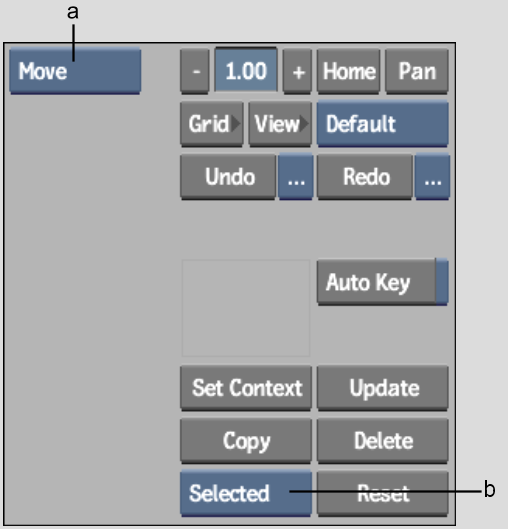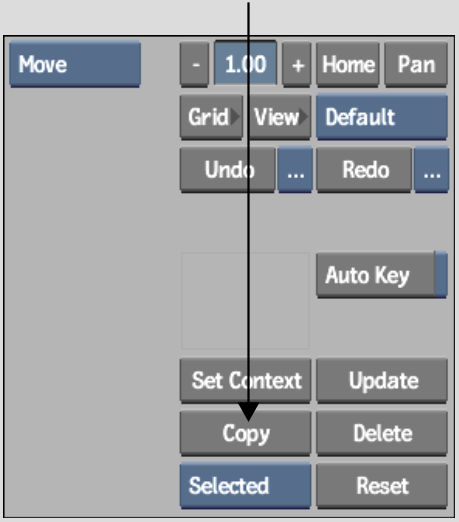Show in Contents

Add to Favorites

Home: Flame

About Nodes

Accessing the Modular Keyer

Adding Clips to the Pipeline

Working with Nodes
This section describes how to perform basic
operations to set up your pipeline, such as adding nodes to the
pipeline and moving them.
For information on individual nodes and where
on the pipeline they can be used, see
Using Nodes and
Nodes Placement Table.
Selecting Nodes on the Pipeline
You can select individual nodes, branches,
all nodes in the pipeline, or all nodes in the schematic. You can also
use the Ctrl key to
select a combination of nodes.
To
select nodes in the schematic:
- Select
Move from the Edit Mode box.
- Select
the node(s) as follows.
| To select: |
Do this: |
| One node |
Select Selected from the Selection box and click the
node.
|
| A branch |
Select Branch from the Selection box and click anywhere
on the branch.
|
| All nodes on pipeline |
Select Graph from the Selection box and click anywhere
on the pipeline.
|
| All nodes in schematic |
Select All from the Selection box and click any node. |
| A combination of nodes |
Press Ctrl and drag
a rectangle around the nodes. The current option in the Selection
box does not affect this type of selection.
|
Selected nodes have a white border.
NoteA yellow border indicates both that a node
is selected and that its menu is the active menu.
Adding Nodes to the Pipeline
You
can add nodes to the pipeline to use while building your key. For
example, you can place several garbage mask nodes on the pipeline.
Most nodes can be placed anywhere on the pipeline.
There are a few exceptions when it comes to the pipes of blend nodes.
Certain nodes do not function on some pipes because of the way the
pipes operate. See
Blend Nodes.
The method for adding nodes to blend node pipes
differs from the method for adding them to branches:
- When
you add a node to the CBlend and MBlend pipes, you can simply drag
and drop them onto the pipe and they are “attached”.
- When
you add a node to branches of the pipeline (for example, to the
Back branch), you need to cut the branch at the appropriate location,
connect it to the new node, and reconnect the branch to the rest
of the pipeline.
To add a node to the CBlend and MBlend
pipes:
- Scroll
the node bar to display the node type you want by clicking on any
node type and dragging to the left or right.
- Do
one of the following:
- Drag
a node type to the schematic and release it in the approximate location
you want it to appear.
- Double-click
a node type. The new node appears to the right of the most recently
selected node, or group of nodes, in the pipeline. If no node was
previously selected, the new node appears in the center of the schematic.
- To
use the node, it must be connected to the pipeline. Drag the node
over one of the blend pipes and release the cursor.
| To place the node: |
Do this: |
| Between two nodes. |
Position it between the two nodes such that it is touching both
nodes.
|
| At the beginning of a pipe |
Overlap it with the first node and move it back a bit. |
| At the end of a pipe |
Overlap it with the last node, move it ahead a bit, and
release the cursor.
|
The node is added to the pipeline.
NoteIf the node is not added to the pipeline
when you release the cursor, it is possible that the node cannot
be added at that location. For example, you cannot add a Colour
Curves node to the lower CBlend pipe. To learn more about the types
of nodes you can add to the CBlend and MBlend pipes, see
Blend Nodes,
and
Nodes Placement Table.
To
add a node to branches:
- Scroll
the node bar to display the node you want by clicking on any node
and dragging to the left or right.
- Click
the node and drag the cursor to the schematic.
The cursor changes to an arrow-headed cross.
- Release
the cursor.
The node appears in the schematic.
- Drag
the node closer to the location on the branch where you want to
add it.
- Select
Parent from the Edit Mode box.
- Drag
the cursor across the branch where you want to add the node.
The portion of the branch between the previous
and next items disappears.
- Drag
the cursor from the front of the previous clip or node (or its Result
tab) to the back of the new node.
If the node has source tabs, attach the branch
to the front, back, or matte tab, depending on the type of node.
See
Using Nodes.
NoteYou can also use the output (result image)
of any node on the pipeline as an input source for the new node.
This includes the output of nodes along the pipes of blend nodes.
The branch is connected to the new node.
- Drag
the cursor from the result tab of the new node to the back of the
next node (or to the appropriate source tab—see note, above).
Moving Nodes
You
can move a node from one part of the pipeline to another. For example,
you can move a garbage mask to the beginning of a branch on the
pipeline.
To
move a node:
- Select
Move from the Edit Mode box.
- Detach
the node from the pipeline:
- If
it is on a blend node pipe, Ctrl+Alt-click
the node. It is detached from the pipe, and is selected (shown by
its yellow border).
- If
it is on a branch, select Parent from the Edit Mode box and drag
the cursor across the branches that connect it to the pipeline.
Reconnect the branch without the node, then return to Move mode.
- Drag
the node over the pipeline where you want to add it and release
the cursor. See
Adding Nodes to the Pipeline.
Copying Nodes
You can copy one or more nodes and place the
copies elsewhere on the schematic. All the settings of a copied
node are included in the copy.
To
copy one or more nodes:
- Select
the nodes. See
Selecting Nodes on the Pipeline.
- Click
Copy.
Copies of the nodes appear on the schematic.
The copies are selected (shown by the yellow border).
- Drag
the copies over the pipeline where you want to add them and release
the cursor. See
Adding Nodes to the Pipeline.
Deleting Nodes
When
you delete a node from the pipeline, all the associated information,
including any unsaved work, is also deleted. There are several methods
you can use to delete nodes:
- Select
the nodes and then delete them.
- Switch
to Delete mode and then click the nodes you want to delete.
- Drag
the nodes off the desktop.
To
select and delete one or more nodes:
- Select
the nodes. See
Selecting Nodes on the Pipeline.
- Click
Delete.
- Click
Confirm to delete the nodes, or click elsewhere to cancel.
To
use Delete mode:
- Select
Delete from the Edit Mode box.
- Click
the node you want to delete.
- Click
Confirm to delete the node, or click elsewhere to cancel.
TipTo override Confirm, press Alt as you click the node.
- Repeat
steps 2-3 for any other nodes you want to delete.
- Return
to Move mode.
To
delete by dragging:
- From
the Edit Mode box, select Move.
- From
the Selection box, select Current, Branch, Graph, or All.
- In
the schematic, click a node and drag either to the top or the bottom
of the desktop.
The cursor changes to a green recycling icon.
- Click
Confirm to delete the nodes, or click elsewhere to cancel.
Updating Nodes
All
the nodes in the pipeline are not updated or processed when a change
is made to the pipeline. This is to save time if processing is not
needed. For example, when you make a change in one node, that node
and all previous nodes in the branch are updated immediately, but
not the subsequent nodes.
In the pipeline, the status of a node is indicated
differently depending on the type of node.
| Node Type |
Unprocessed |
Processed |
| Single Input |
The arrowhead at the right side of the node is red. |
The arrowhead at the right side of the node is green. |
| Multiple Input |
The label under the node is black. |
The label under the node is white. |
| Blend |
The arrowhead is red and the label is black. |
The arrowhead is green and the label is white. |
You can opt to have nodes updated on an “as
needed” basis, or update them manually:
- With
automatic update, when you click a node, that node and all nodes
before it on the pipeline are updated since the previous nodes are
required to produce the correct result for the node. For example, if
you click the Result node, all nodes in the pipeline are updated.
- With
manual update, you selectively update nodes.
To
set the update mode:
- Display
the Setup menu.
- Use
the Auto Update button to set the update mode.
| For: |
Do this: |
| Automatic update |
Enable the Auto Update button. |
| Manual update |
Disable the Auto Update button. |
NoteAuto Update only affects the schematic (it
does not affect processing while you are working within nodes).
To
update a node automatically:
- Select
Move from the Edit Mode box.
- Click
the node.
NoteIf the node does not get updated, make sure
that all multiple input nodes in branches leading to the node have
the required source inputs.
To
update a node manually:
- Select
the node. See
Selecting Nodes on the Pipeline.
- Click
Update.
The selected node and all previous nodes are
updated.
NoteIf the node does not get updated, make sure
that all multiple input nodes in branches leading to the node have
the required source inputs.
Renaming Nodes and Clips
Nodes
are given a default name composed of the node name and a number
appended to it, for example, gmask1, gmask2. When you select a node
or clip, its name is displayed in the Name field.
Names are also displayed in the schematic, below
the clip or node (with the exception of the nodes on blend pipes).
Rename nodes and clips to help keep track of them as the pipeline
grows.
NoteYou cannot rename clips that are brought
into the schematic using the Add Clip button.
To
rename a node or clip:
- Select
the node or clip.
- Click
the Name field.
The on-screen keyboard appears.
- Click
Esc to delete the previous name and type a new name.
- Click
Enter to save the new name or click EXIT Keyboard to cancel.














